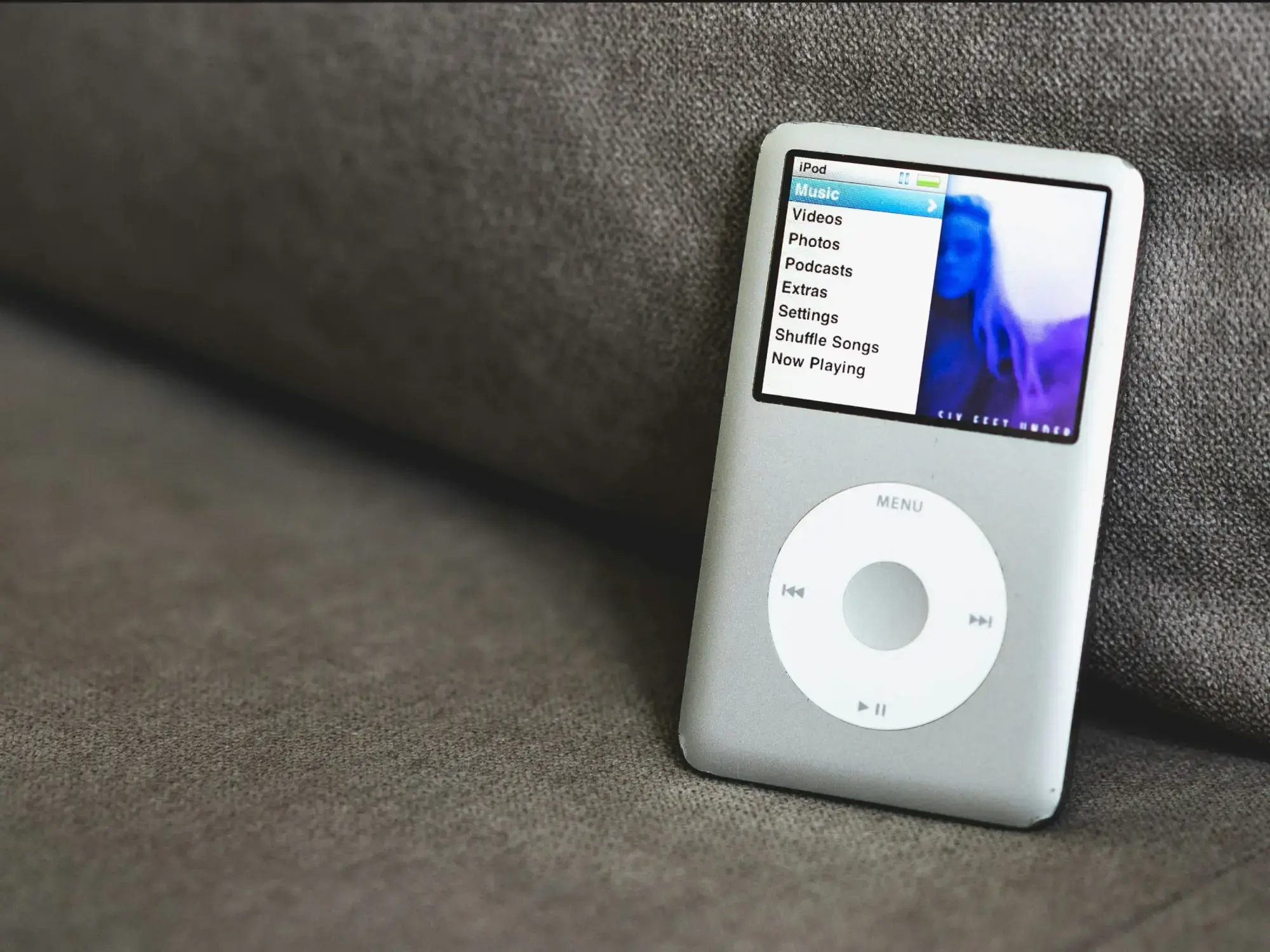
ByePod
Our founder Jscobi looks at the rise and fall of the iPod and the market forces driving them.
In the technology industry, we’re always looking ahead — always seeking the next best thing that’ll propel us to the next platform for innovation. Sometimes, however, it’s important to recognise the past to see where the true step-changes happened as an indicator of how far we’ve come. Apple’s announcement that they were discontinuing the iPod last week was a reminder of one such moment — the moment we were given the ability to have 10,000 songs in our pocket.
At the time of the iPod’s release, Apple said “With iPod, Apple has invented a whole new category of digital music player that lets you put your entire music collection in your pocket and listen to it wherever you go. With iPod, listening to music will never be the same again.” They were right in a variety of ways. This was much more than a new iteration of a portable music player like a tape cassette, MiniDisk, or CD player — it was an entirely new way of thinking about music that changed the industry forever. Here are my thoughts about Apple’s announcement.
A new measurement of success
Within 3 years of the first iPod being released in 2001, the official music charts took downloads into consideration due to iTunes’ overwhelming popularity and its fast-paced cannibalization of the CD market. This in turn paved the way for streaming and video views to also be counted as a new generation of consumers ditched the old methods for a much more user-friendly way to listen to music, both on the move and at home.
How many products have changed the way an entire industry measures success? The Official Charts website mentions the creation of iTunes by name when discussing whether or not they include downloads. Suddenly music artists worldwide found themselves scrambling for strategies on how to optimise their performance for downloads. Their marketing teams moved away from making their CD covers look brilliant, concentrating rather on bonus digital material to encourage people to download their albums online. The iPod didn’t just change the delivery method of music, it changed the way the entire industry operated.
MP3s over CDs
The iPod introduced the first method of portable music where you didn’t need to plug some kind of music storing device into a piece of hardware that would read and play the music.
In building IRIS, I’ve had the pleasure of working closely with James Vincent, the ex-CMO at Apple, who was responsible for launching the first iPod to the world. We’ve had many conversations about the challenges of changing perceptions from the historical thinking of putting something in (tape, CD, MiniDisk, LP) to getting music out, and how he had to re-educate the world on how we were going to consume music in the future.
Suddenly there was no need to have a CD wallet the weight of a small child in your car or your backpack. The iPod allowed you to download a previously unfathomable amount of songs onto a device smaller than your mobile phone — and shockingly, it didn't get heavier the more you put on there.
We spend a considerable amount of time commuting, dog walking, travelling abroad, and generally just getting from point A to point B — I still remember the first time I could pick specific albums when going for a run. Operating the incumbent CD player was a battle; any bump in the journey would lead to an irritating skip in the track, making running with music almost impossible. This portability of music was what set the iPod apart.
In turn, this also changed the way music was produced. The elegant art of compiling an album intended to be consumed from start to finish was forgotten. The magic of an artist captivating their audience through the journey of their album became a luxury lost. I still marvel at albums like Graceland by Paul Simon or The Dark Side of the Moon by Pink Floyd. No matter your taste in music, you can't deny the artistic genius of these compositions.
Soon after the iPod’s release, Apple’s trademark white headphones started to appear in everybody’s ears — on the bus, at the airport, or just walking around. Not only did the iPod bring some amazing advancements in audio, it also brought its iconic adverts with bold, colourful backgrounds highlighting those white headphones and turning them into a lasting fashion statement. James, I tip my cap!
Music for the masses
With this increased portability of music came increased accessibility of music as well. Suddenly, more people could listen to their favourite songs, more often. Although there was a larger upfront cost, the cost per song began to decrease, and people could afford to build a larger collection of music.
Combine these decreasing costs with more chances in the day to listen and algorithms that suggest other songs you may like, and you see a whole world of opportunity to enjoy a much larger selection of music. Where before you may have been limited to your proximity to a music shop or what your local supermarket might have in stock, the iPod only required an internet connection to explore everything from 80s glam rock to the latest reggaeton track to come out of Ecuador.
It took a single product to break down (almost) all of music’s previous limitations. But like with most new innovations, there is always going to be a new one around the corner ready to usurp the previous one’s throne — which leads us to…
Enter the challengers
The iPod’s innovations were the reason for its initial booming success, but also opened the door to its eventual redundancy. The first nail in the iPod’s coffin came from its own creator — Apple’s iPhone. Originally, its single purpose design allowed the iPod to become the foremost expert for digital music playback. It didn’t spread itself thin and allowed for all efforts to be concentrated on a near-perfect music playing experience. The iPhone changed all of that. Suddenly you had a device that could do everything the iPod could do, and much more. When the iPhone was released in 2007, its astounding market growth cannibalised the market of the iPod — after all, there was no real need to own both. The iPhone currently holds around a 50% market share of the US smartphone market, which arguably means 50% of the population no longer needs an iPod.
The second big trend that spelt the end of the iPod was the rise in streaming. Music streaming is now worth around 84% of the music industry, driven by huge demand in services such as Apple Music, Spotify, Tidal, Deezer, and YouTube. The digital revolution created by the iPod slowly evolved away from paying for the download of individual songs and albums and towards the monthly subscription model that streaming services offer. This was caused by even greater cost effectiveness and accessibility offered by streaming, as well as global technological advancements in internet speeds and increased demand for video content. Again, the market moved away from the iPod and towards other products.
The future of audio
So where has the invention of the iPod left us now, and what path has it set us on in the future? It’s clear the innovations driven by it were a huge boost for music lovers everywhere. Whilst vinyl sales are again beginning to rise as people yearn for a more traditional experience, the invention of wide-spread, accessible, and portable music was a massive success.
One of the drawbacks we have yet to mention though, which is another driver of the resurgence in vinyl sales, is the sacrifice in quality that the increase in quantity created. The cost of 10,000 songs in your pocket was a huge decrease in file size, and quality, of the songs you downloaded. This is one trend driven by the iPod that was more negative than positive. The good news is that we don’t need to go back to Sony Walkmans and CD-cleaning equipment to get that quality back.
This was one of many reasons why I founded IRIS. We believe that whilst innovations in video quality and audio quantity have been fantastic, audio quality has largely been ignored. It’s our mission to restore that quality back to how it sounded when it was recorded. Our products like Neuro, the IRIS Flow Headphones, and IRIS Clarity are all designed to restore audio to its former glory and deliver the peak audio experience.
The iPod’s legacy is that it brought convenience to the way we listen to audio — both in the way we purchase it and consume it. What we need to do now as an industry is to find that perfect balance between the convenience it introduced, the quality of the audio, and the emotion we feel when we listen. Keep an eye on our social media channels and blog to find out how we’re going about restoring that balance, and bringing quality back to audio.


